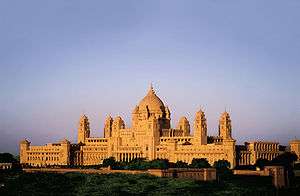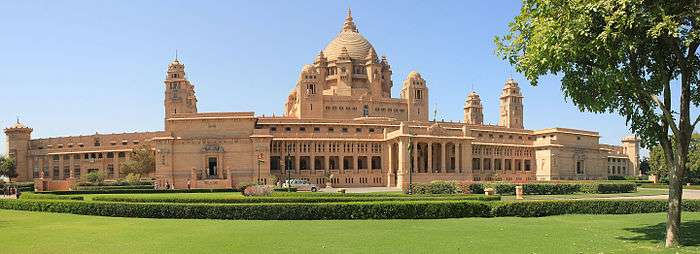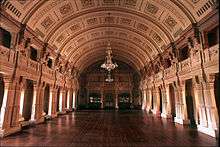Umaid Bhawan Palace
| Umaid Bhawan Palace, Jodhpur | |
|---|---|
 Umaid Bhawan Palace | |
 Location within Rajasthan | |
| General information | |
| Architectural style | Beaux Arts style and a blend of eastern and western architectural styles |
| Town or city | Jodhpur |
| Country | India |
| Construction started | 1928 |
| Completed | 1943 |
| Client | Maharaja Sawai Jai Singh II |
| Technical details | |
| Structural system | Golden yellow or dun coloured sand stone |
| Design and construction | |
| Architect | Vidyadhar Bhattacharya and Sir Samuel Swinton Jacob |
| Engineer | Henry Vaughan Lanchester |
Umaid Bhawan Palace, located at Jodhpur in Rajasthan, India, is one of the world's largest private residences. A part of the palace is managed by Taj Hotels. Named after Maharaja Umaid Singh, grandfather of the present owner Gaj Singh of the palace, this edifice has 347 rooms and serves as the principal residence of the erstwhile Jodhpur royal family. A part of the palace also houses a museum.
Umaid Bhawan Palace was called Chittar Palace during its construction due to use of stones drawn from the Chittar hill where it is located. Ground for the foundations of the building was broken on 18 November 1929 by Maharaja Umaid Singh and the construction work was completed in 1943. The Palace was built to provide employment to thousands of people during the time of famine.
Recently, Umaid Bhawan Palace was awarded as the World's best hotel at the Traveller's Choice Award, which was organised by TripAdvisor.[1][2]
History
History of building the Umaid Bhawan Palace is linked to a curse by a saint who had said that a period of drought will follow the good rule of the Rathore Dynasty. Thus, after the end of about 50-year reign of Pratap Singh, Jodhpur faced a severe drought and famine conditions in the 1920s for a period of three consecutive years. The farmers of the area faced with famine conditions sought the help of the then king Umaid Singh,[3] who was the 37th Rathore ruler of Marwar at Jhodpur,[4] to provide them with some employment so that they could survive the famine conditions. The king, in order to help the farmers, decided to build a lavish palace. He commissioned Henry Vaughan Lanchester as the architect to prepare the plans for the palace; Lanchester was a contemporary of Sir Edwin Lutyens who planned the buildings of the New Delhi government complex. Lanchester patterned the Umaid Palace on the lines of the New Delhi building complex by adopting the theme of domes and columns.[3] The palace was designed as an extraordinary blend of western technology, and many Indian architectural features.[4]
The palace was built at a slow pace as its initial objective was to provide employment to the famine-stricken farmers of the locale. The foundation stone was laid in 1929. About 2,000 to 3,000 people were employed to build it.[5] However, the actual occupation of the palace by the Maharaja came only after its completion in 1943, very close to the period of Indian Independence. There was criticism in some quarters for embarking on an expensive project but it had served the main purpose of helping the citizens of Jodhpur to face the famine situation.[3] The estimated cost of building the palace was Rs 11 million.[6] When it opened its gilded doors in 1943 it was considered as one of the largest royal residences in the world.[4]

The site chosen for the palace was on a hill known as Chittar hill in the outer limits of Jodhpur, [7] after which the palace is also known,[8] where no water supply was available near by and hardly any vegetation grew as hill slopes were rocky. The building material required was not close by as sandstone quarries were at quite a distance. Since the Maharaja had the foresight to bring his project to fruition, he built a railway line to the quarry site to transport the building material. Donkeys were inducted to haul soil to the site. The sandstone transported by rail was dressed at site into large blocks with interlocking joints so that they could be laid without the use of mortar and thus create a wonderful edifice.[3]
The palace was built with "dun-colourd" (golden – yellow) sandstone with two wings. Makrana marble has also been used, and Burmese teak wood has been used for the interior wood work.[3][6] When completed the palace had 347 rooms, several courtyards, and a large banquet hall which could accommodate 300 people. The architectural style is considered as representing the then in vogue Beaux Arts style, also known as Indo-Deco style. However, for many years the palace did not function fully on account of many tragic events in the royal family. Umaid Singh who stayed in the place for only four years died in 1947. Hanumant Singh who succeeded him also died at a young age; he had just won in the 1952 General Elections and was returning home after this win when his plane crashed and he died. Gaj Singh II who succeeded his father then decided in 1971 to convert a part of the palace in to a hotel.[3]
Features
The Palace is divided into three functional parts – the residence of the royal family, a luxury Taj Palace Hotel, and a Museum focusing on the 20th century history of the Jodhpur Royal Family.[3]
Palace


The entire palace complex built with sandstone and marble is set in an area of 26 acres (11 ha) of land including 15 acres (6.1 ha) of well tended gardens. The palace, magnificent in its lavish proportions, consists of a throne chamber, an exclusive private meeting hall, a Durbar Hall to meet the public, a vaulted banquet hall, private dining halls, a ball room, a library, an indoor swimming pool and spa, a billiards room, four tennis courts, two unique marble squash courts,[4] and long passages.[9]
The interior central dome sits above the sky blue inner dome. The inner vaulted dome is a major attraction in the palace which rises to a height of 103 feet (31 m) in the interior part which is capped by an outer dome of 43 feet (13 m) height. The entry to the palace has decorations of the Coat of arms of the Rathore Royal family. The entry leads to the lobby which has polished black granite flooring. The lounge area has pink sandstone and marble floors.[3] Maharaja Gaj Singh, known as "bapji", stays in a part of the palace. The architecture of the palace is described as an amalgam of lndo-Saracenic, Classical Revival and Western Art Deco styles. It is also said the Maharaja and his architect Lanchester had considered the features of Buddhist and Hindu edifices such as the Temple Mountain-Palaces of Burma and Cambodia, and in particular the Angkor Wat in preparing the layout and design of the palace.[7] The interior of the palace is in art deco design.[8] The interior decoration is credited to J.S. Norblin, a refuge from Poland, who created the frescoes in the throne room on the east wing. An architectural historian commented that "it is the finest example of Indo-deco. The forms are crisp and precise".[10]
Hotel

The hotel wing of the palace is run by the Taj Group of Hotels and is called the 'Taj Umaid Bhawan Palace Jodhpur. It has 70 guest rooms including the luxurious "Regal and Vice Regal Suites" and the fabulous "Maharaja" and "Maharani suites" with art deco style decorations, the latter is fitted with a bath tub carved from a single block of pink marble said to be the only one of its type in India. The Maharani suite also has parquet flooring and has a terrace which provides scenic views of the garden. The bed room has an attached kitchen and the furnishing here is in pink and peach colour. The bed is also fitted with an art feature of a woman sitting on a lion. The Maharaja Suite has manly furnishings in leopard skin, and with black marble flooring and a curved mirrored dome. Both the rooms are decorated with murals. The banquet hall of the palace now forms the large restaurant.[4][3]
Museum
The museum has exhibits of stuffed leopards, a very large symbolic flag gifted to Maharaja Jaswant Singh by Queen Victoria in 1877, an impressive "quirky" collection of clocks in windmill and light house shapes, and photographs of the elegant art-deco interior of the palace.[6] The classic cars of the Maharajas are also on display in the garden in front of the museum. Glass, porcelain wares, memorabilia, and information on the building of the palace are also part of the exhibits. The Darbar Hall, which is part of the museum, has elegant murals and also substantial number of miniature paintings, armour and an unusual collection of household paraphernalia that was in vogue in the 1930s, which were costly and then not found in India.[8][10] October to March, during winter season, are the best months to visit the palace and the museum.[4]
References
- ↑ "Jodhpur's Umaid Bhawan Palace bags TripAdvisor's best hotel in the world award". Retrieved 2016-04-16.
- ↑ "TripAdvisor's Travellers' Choice Awards 2016 names Umaid Bhawan the best hotel in the world : Travel Buzz, News - India Today". Retrieved 2016-04-16.
- 1 2 3 4 5 6 7 8 9 Bentley 2011, p. 123.
- 1 2 3 4 5 6 Katritzki, p. 107.
- ↑ Bentley 2011, p. 123-24.
- 1 2 3 Brown & Thomas 2008, p. 306.
- 1 2 Vinnels & Skelly 2002, p. 245.
- 1 2 3 Singh 2010, p. 233.
- ↑ Nath, Holmes & Holmes 2008, p. review.
- 1 2 Betts & McCulloch 2013, p. 130.
Bibliography
- Bentley, Cheryl (2011). A Guide to the Palace Hotels of India. Hunter Publishing, Inc. ISBN 978-1-58843-970-3.
- Betts, Vanessa; McCulloch, Victoria (2013). India – The North: Forts, Palaces, the Himalaya Dream Trip. Footprint Travel Guides. ISBN 978-1-907263-74-3.
- Brown, Lindsay; Thomas, Amelia (2008). Rajasthan, Delhi & Agra. Ediz. Inglese. Lonely Planet. ISBN 978-1-74104-690-8.
- Katritzki, Freda. The World of Private Castles, Palaces and Estates. Chateaux Prives. ISBN 978-2-9524142-1-0.
- Nath, Aman; Holmes, Fred R.; Holmes, Anna Newton; Paschira, Amit (2008). Jodhpur's Umaid Bhawan: The Maharaja of Palaces: a Book. India Book House. ISBN 978-81-7508-511-4.
- Singh, Sarina (2010). Lonely Planet India. Lonely Planet. ISBN 978-1-74220-347-8.
- Vinnels, David; Skelly, Brent (2002). Bollywood showplaces: cinema theatres in India. E & E Plumridge in collaboration with Decorum Books.
External links
 Media related to Umaid Bhawan Palace at Wikimedia Commons
Media related to Umaid Bhawan Palace at Wikimedia Commons
Coordinates: 26°16′51″N 73°02′49″E / 26.28083°N 73.04694°E